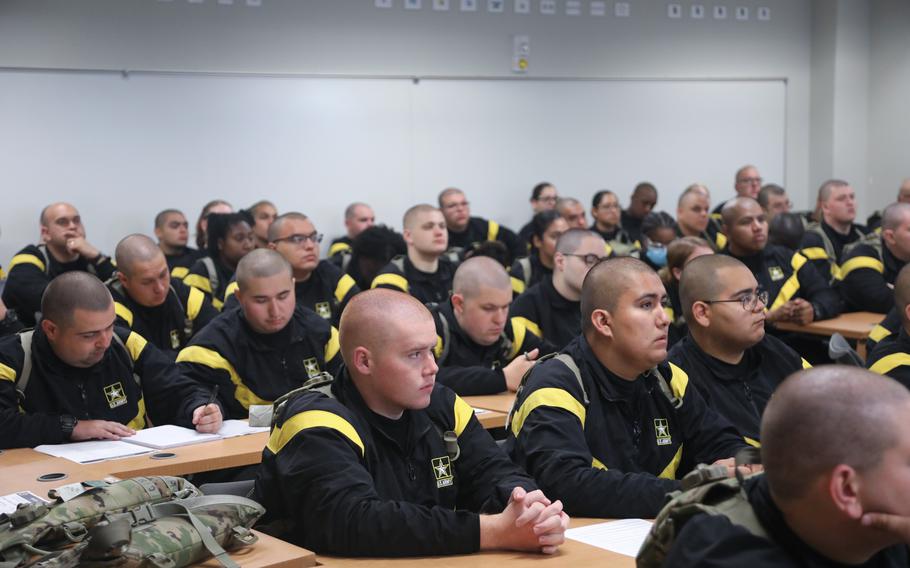
Students in the fitness track of the Army’s Future Soldier Preparatory Course receive resiliency training at Fort Jackson, S.C., on Dec. 13, 2022. (Keion Jackson/U.S. Army)
The size of the active-duty military authorized in this year’s annual defense bill is dropping yet again, bringing it in closer alignment to the actual number of people the services have been able to recruit.
The Fiscal Year 2024 National Defense Authorization Act, an annual bill that outlines defense priorities and spending, authorized a total of 1,283,700 troops to serve in the active-duty Army, Navy, Marine Corps and Air and Space Forces. That is down nearly 5% from the 1,348,040 authorized two years ago.
However, because of challenges to recruiting, the actual number of troops on active duty has fallen short of authorized levels recently. Last year there were roughly 1,286,027 active troops, according to the Defense Department.
The figure in the bill, which won final Congressional approval last week, actually is lower than the 1,305,400 active-duty troops the Defense Department proposed in its budget request earlier this year. The 2024 bill is awaiting President Joe Biden’s signature to become law.
The services collectively missed recruiting goals by 41,000 recruits in fiscal year 2023, which ended Sept. 30, Ashish Vazirani, acting undersecretary of defense for personnel and readiness, told the House Armed Services Committee subpanel on military personnel last week.
“That number understates the challenge before us as the services lowered in strength goals in recent years, in part because of the difficult recruiting environment,” he said.
Only the Marine Corps and Space Force met recruiting goals last year, according to service officials. The Army, which is the largest of the service branches, had the most difficult time recruiting and fell short 15,000 recruits in 2023.
The military has been restructuring and reducing troop levels since ending the wars in Iraq and Afghanistan. Yet the ongoing struggle to recruit enough people to fill its ranks has brought those levels lower than leaders would like, said Mark Cancian, a retired Marine colonel and senior adviser at Center for Strategic International Studies, a Washington-based bipartisan think tank.
“The military’s problem is the economy. If I had to pick one problem, that’s it. The better the economy is — particularly, the lower the unemployment rate — the harder it is to recruit people,” Cancian said.
Congress authorized 445,000 active-duty troops for the Army; 337,000 for the Navy; 320,000 for the Air Force; 172,300 for the Marine Corps; and 9,400 for the Space Force. That is a drop in numbers for each service except the Space Force, which is the newest service branch and still growing its ranks.
While the Marine Corps, which dropped by 4,700, and Space Force are on track, the Air Force and Navy are only slightly veering from each service’s overall strategy, Cancian said.
Thes Navy reduced its authorized strength by 17,000 active-duty sailors, and the Air Force dropped by 5,344.
“That’s part of their plan, too. … They’re retiring a lot of ships early with the idea being that they’ll invest in new capabilities. But, of course, it’ll take years for those to come online,” Cancian said. “They would prefer to be at a higher level, maybe in the 340,000 [range] at least, but because they are divesting to invest that makes it easier for them to take a personnel cut.”
The Air Force is in a similar situation with the retirement of some of its aircraft platforms, Cancian said.
The Army, however, is “facing some tough choices,” he said. They’d prefer to have around 484,000, he said. Last time the Army sat at that level was fiscal year 2021, according to the Congressional Research Service.
Instead, the new defense bill sheds 7,000 active-duty personnel from the service.
Leaders will need to reorganize unit structure soon to adjust to its reduced size, Cancian said. Army Secretary Christine Wormuth has commented there are plans to begin aligning the personnel levels with the structure in 2024, “which they hate doing.”
“We’ll probably see in the 2025 budget what they’re planning to do there,” he said.
Michael Linick, retired Army colonel and senior international and defense policy analyst with Rand, said he agrees that the Army is likely sitting at a troop level lower than it would prefer.
“We need to be aware of how personnel decisions we’re making today are going to have to be accommodated as the Army’s end strength fluctuates in the future. It does have downstream impacts that we need to be aware of. The army personnel system does not react with the same speed that the Army force structure does,” Linick said.
All of the services may need to wrestle with moving some jobs to contractors or reservists, Cancian said.
“To be fair to the military, they’ve done a lot of that over the last half century since the end of the draft,” he said. “There’s still arguably more you could do. Maybe it’s not comfortable but I think they’re going to have to sort of wrestle with that.”